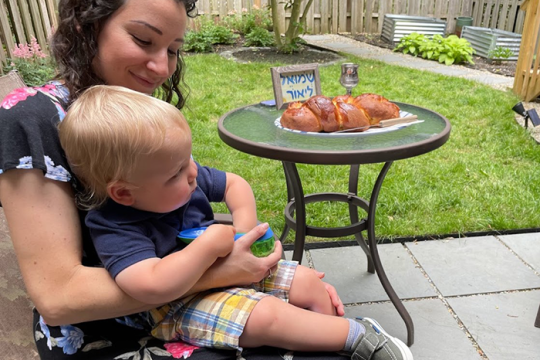
My first experience with a kiddo living in a costume was in college, when I was working as a nanny. He was 3 years old and dressed as a wolf – all the time. In the wolf costume, this little boy growled at his siblings, his peers, and me. He felt quite comfortable in this state of contrary.
His sister, who had a very different disposition, one day put on a kangaroo costume and asked her brother if he wanted to climb into her pouch. My heart melted, and I learned something really powerful: These kids used costumes to navigate their feelings. They didn’t have grown-up words to say what they wanted to say, but as a wolf and a kangaroo, they expressed their feelings perfectly.
Young Esther, one of the stars of the Purim story (find a kid-friendly version here), was thrust into a world of costumes when she dressed up and performed for King Achashverosh. Hiding her Jewishness, she used her costume as a shield of bravery. Though the crown may have been heavy atop her head, might it also have made her stand a little taller? Her flouncy dress may have been cumbersome, but might it also have made her move with a little more confidence?
Without the fancy costume, would Esther have had the courage to ask the king to spare the Jewish people?
For very young children, costumes allow them to try on something new, to be something new. Costumes are a safe way to explore emotions and possibilities. Being the queen allows you to be in charge and a little bossy. You put on a crown, straighten your spine, and feel beautiful.
Being Spiderman allows you to be brave and powerful: With bulging muscles, your towers get taller, and conflicts can be resolved with a little web goop from your wrist.
Being a kitty allows you to be soft and cuddly. Do you want to be the mommy kitty or the baby kitty? The mommy kitty is nurturing and solves all of the problems, while the baby kitty is cuddled, petted, and gets quick response when in distress.
The possibilities are only limited by imagination, and children’s imaginations are not limited.
Every day, I stand at the doorway of my synagogue’s early childhood center greeting children, and every day, I watch as children arrive in crowns, costumes, wings, badges, and bangles. Friends float by in princess dresses and swagger past in muscled superhero getups. On Purim, some will choose to dress as characters from the story and others will choose their favorite TV or superhero character. I couldn’t care less, only that their costume play provides them the opportunity to work through and express, in their own language, how they feel and what they want to know.
Does it express the turmoil of the wolf, the nurture of the kangaroo, the bravery of the queen, or… truly, the possibilities are endless.
Related Posts

Melding Tradition and Innovation: Our Interfaith Toddler Naming Ceremony

Nine Spring-Inspired Hebrew Names


